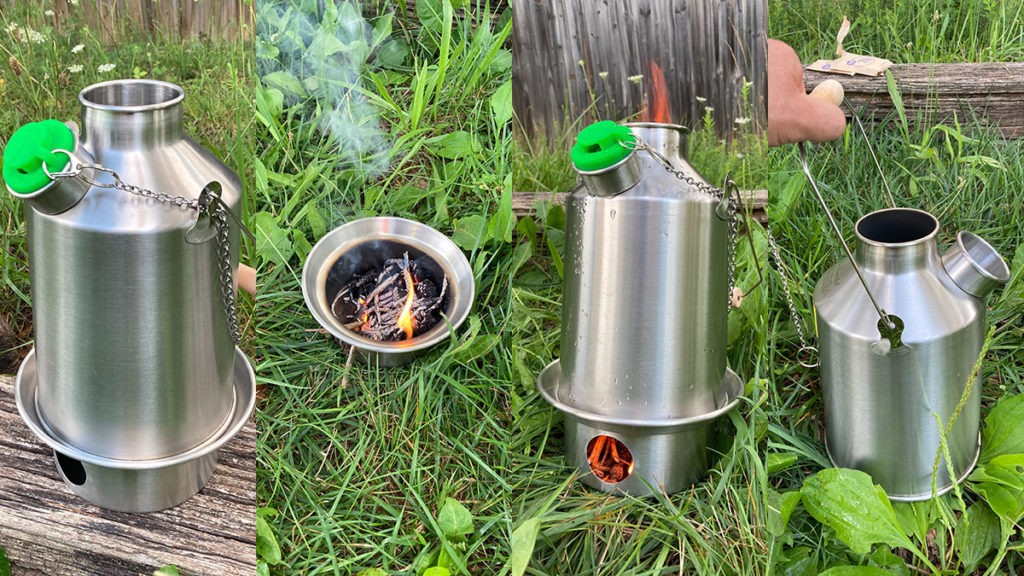
Looking for a rocket stove-style kettle and debating between the Ghillie Kettle vs the Kelly Kettle? Here we’ll be looking specifically at how to use a Kelly Kettle. Functionally, the Ghillie and the Kelly are the same, but there are differences that we’ll cover.
The particular Kelly Kettle unit I’m reviewing here is the Scout model:
Here were my findings…
Table of Contents
A Camping Water Boiler for Natural Fuels
The first thing you need to understand about the Kelly Kettle is that it operates in the exact same manner as a rocket stove. Really, the Kelly Kettle is a rocket stove. That’s why you’re able to boil water incredibly fast with this type of setup, making a Kelly Kettle an ideal means of boiling water post-disaster.
I was able to boil roughly 3.5 cups of water in all of 5 minutes. That was with nothing more than a handful of twigs. To boil that much water over an open fire would have taken a much larger fire, more fuel, more time, and would have created much more smoke as well.
A Kelly Kettle really doesn’t create very much whatsoever. It takes me about 1-2 minutes of having a fire before smoke begins to come out of the top (before that, it’s a pretty big flame). My kettle was filled with boiled water by the five-minute mark, so that means there’s only maybe 3 minutes’ worth of smoke before I’m done.
If you’re in a post-disaster situation where you’re trying to keep a small signature, that’s a boon to survival.
The Kelly Kettle does this because rocket stoves are somewhat analogous to the Dakota fire hole – the type of fire commonly taught by military units training for evasion scenarios.
How to Use a Kelly Kettle in 5 Steps
Using a Kelly Kettle is about as simple as it gets. There are just 5 quick and easy steps to this process.
Step 1 – Fill the Water to the Appropriate Level
The first thing you have to do is to fill the kettle with water. Leave a little bit of space – about half an inch – between the water line and right before the kettle starts to curve upwards. This will allow the water plenty of space to boil without shooting scalding water out of the whistle.
A word to the wise here: only put water in your Kelly Kettle. If you put anything else in there, it’s virtually impossible to clean it out. So, water only. Do all your mixing of other ingredients in other easy-to-wash bowls and such. Not in the Kelly Kettle.
Step 2 – Put the Rubber Whistle on Correctly
There is a rubber whistle that you need to put into the hole. Make sure the opening of the whistle is pointed down. Once more, this is to help ensure that blazing water isn’t getting shot all over the place.
Step 3 – Build Your Base Fire
The next step is to build a fire in the base plate. I do this with very small sticks – the diameter of a #2 pencil or less. These light very easily with a Vaseline-soaked cotton ball and they will get your kettle brewing.
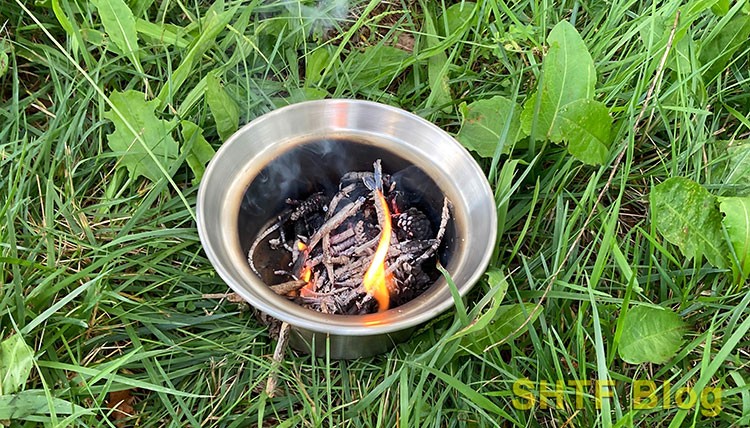
Step 4 – Feed Your Fire
Once you have a solid mini-fire rolling in the base plate, it’s time to set the kettle onto it. Once you do that, a vacuum-like effect will be created. This will suck oxygen through the lower opening, into the flame, and then expel air/heat out of the top of the funnel.
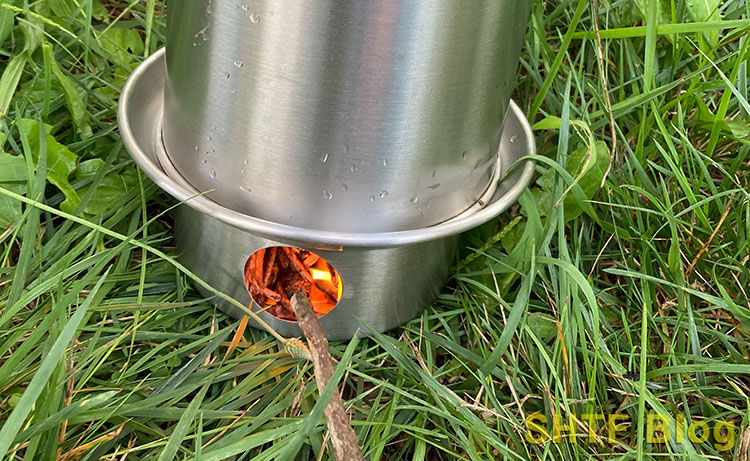
This makes for a very hot and efficient fire.
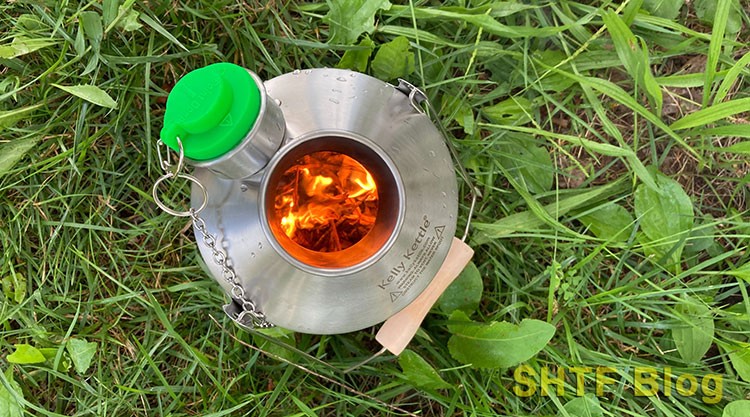
If you’re using the hobo stove to cook, I found it slightly more difficult to get the fire started (when compared with the kettle). I think this is because of the lack of air draw the hobo stove gets. It’s not difficult – just not as easy as fire building with the kettle.
Step 5 – Carefully Pour Out the Water
Wait until you hear the kettle whistle, and you’re good to go! Take the kettle from the fire, unplug the rubber stopper, and use one hand on the wooden handle and another on the chain to pour out the hot water into whatever container you have close at hand.
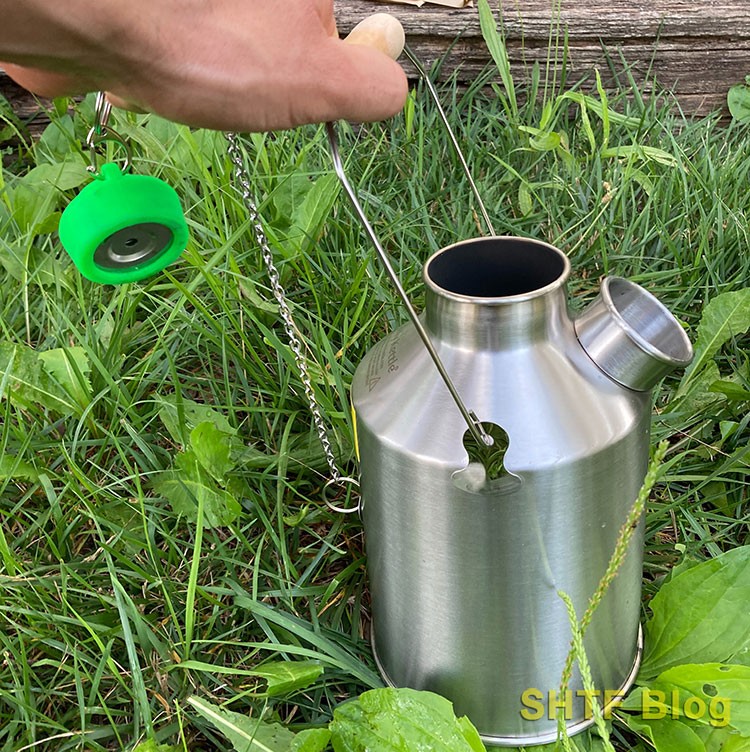
Now that you’ve done this, ensure that you don’t leave your Kelly Kettle on top of the fire. You’ll end up damaging it if you allow it to bake over a fire without water inside. So either fill it up and start again, or let the fire die down without the kettle on it.
Ghillie Kettle vs Kelly Kettle
Functionally, the Ghillie Kettle and Kelly Kettle operate in the same manner. The biggest difference is that the Ghillie Kettle only comes in aluminum, whereas the Kelly Kettle is available in both stainless steel and aluminum. However, Kelly Kettles only include a stainless steel firebase. Aluminum firebases burn out over time.
There are other differences, however, mainly subtle ones around weight and size. The following charts break down a comparison between the various models, a Ghille Kettle vs Kelly Kettle comparison by model type.
| Kelly Kettle – Base Camp | Ghillie Kettle – Adventurer | |
| *Material | Stainless Steel (2.55 lbs) Aluminium (1.8 lbs) | Does Not Make Stainless Steel Kettles Aluminium (1.98 lbs) |
| Volume | 1.6 ltrs / 54oz | 1.42 ltrs / 48oz |
| Packed Height | 34cm / 13 inch | 34cm / 13 inch |
| Diameter | 18.5 cm / 7.3 inch | 18.5 cm / 7.3 inch |
| **Fire-Base | Stainless Steel | Aluminium |
| Whistle | Yes – Green Silicone | Yes – Metal |
| Kelly Kettle – Scout | Ghillie Kettle – Explorer | |
| *Material | Stainless Steel (2.26 lbs) Aluminium (1.5 lbs) | Does Not Make Stainless Steel Kettles Aluminium (1.76 lbs) |
| Volume | 1.2 ltrs / 54oz | 1 ltrs / 48oz |
| Packed Height | 26.5cm / 10.4 inch | 28cm / 11 inch |
| Diameter | 18.5 cm / 7.3 inch | 18.5 cm / 7.3 inch |
| **Fire-Base | Stainless Steel | Aluminium |
| Whistle | Yes – Green Silicone | Yes – Metal |
| Kelly Kettle – Trekker | Ghillie Kettle – Maverick | |
| *Material | Stainless Steel (1.5 lbs) Aluminium (1.1lbs) | Does Not Make Stainless Steel Kettles Aluminium (1.1lbs) |
| Volume | 0.6 ltrs / 20oz | 0.5 ltrs / 16.9oz |
| Packed Height | 26.5cm / 10.4 inch | 27cm / 10.6 inch |
| Diameter | 14 cm / 5.5 inch | 14 cm / 5.5 inch |
| **Fire-Base | Stainless Steel | Aluminium |
| Whistle | Yes – Green Silicone | Yes – Metal |
| Kelly Kettle – Hobo Stove | Ghillie Kettle – Hobo Stove | |
| Material | Stainless Steel | Aluminium |
| Packs Inside the Base | Yes | No. Has to be carried separately. |
| Kelly Kettle – Pot/Base Support | Ghillie Kettle – Pot Support | |
| Material | Stainless Steel | Aluminium |
| Flat Packs | Yes Steel will not melt & retains its shape. Can also be used under the Fire-Base to prevent ground scorch. | Yes Alu melts & can fuse the 2 pieces together |
| Kelly Kettle – Cook Sets | Ghillie Kettle – Cook Sets | |
| Material | Stainless Steel | Aluminium |
Note: Each of the Kelly Kettle sizes is available in either Stainless Steel or Aluminum.
Outside of the technical differences between the two brands, the main difference is that Kelly Kettle uses a rubber stopper whistle, while Ghillie Kettle uses a metal stopper whistle.
Perhaps another difference is that the Kelly Kettle is manufactured in Ireland, while the Ghillie Kettle is made in England. The Ireland vs England rivalry lives on through these kettles.
Other Features of the Kelly Kettle
Boiling water isn’t the only thing that you can do with a Kelly Kettle. If you buy the Scout model, as I’m reviewing here, you receive a full mess kit that will allow you to cook for two people. Aside from the kettle itself, other gear that is included is:
- A hobo stove
- A cook pot
- A cook pot lid (this doubles as a sauce pan)
- Two cups
- Two plates (that double as frying pans)
- A pot gripper
- A grate
- A pot support
- Two lip protectors for the cups
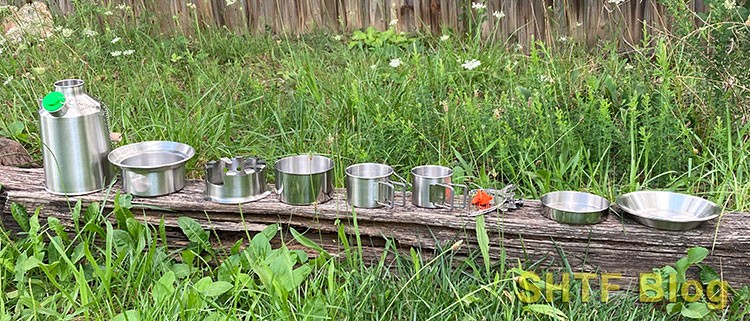
As you can see, that’s a lot of stuff! If you’re in the market for a full mess kit for a bug out backpack for you and your family, this is it!
Not only can you boil water to make your coffee, tea, oatmeal, soups, and the like incredibly fast, but you can also fry up just about whatever you can imagine on the hobo stove!
The lip protectors I didn’t initially see the need for until I made my cowboy coffee. The mug takes a very long time to cool down, and without those little rubber protectors, it’s very easy to burn your lips on that hot metal. I’m a proponent of them now.
Summary
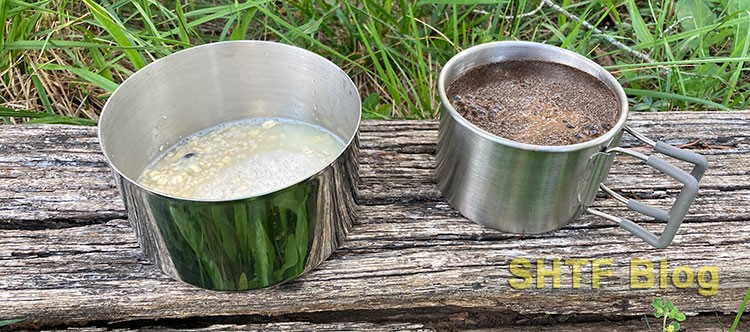
So, should you spend your money on a Kelly Kettle? A Ghillie Kettle? Are they worth it? Mine came from Sagan Life, and it was worth it in my opinion.
The actual how to use a Kelly Kettle is very easy. Conveniently, a great majority of the food items that I eat while I’m out on the trail and backpacking require boiled water to begin with. The Kelly Kettle makes it so that I don’t have to worry about carrying fuel canisters with me everywhere out in the woods (the fuel to a Kelly Kettle is everywhere). It allows me to actually sit down to eat much sooner than a traditional backpacker stove does.
These types of rocket stoves are lightweight, and the stainless steel Scout model gives me enough of a mess kit so that my entire family can eat out in the woods. Pack one with a bug out fire starter and you can make drinking water safe and use hot water for cooking.
It’s not that we’re all out living in the woods together, but for camping; or if there was a wildfire swooping through and I need to quickly grab a bug out bag, hop in the car, and get out as fast as possible; I have the knowledge that I can boil water for as long as I can find small sticks and make a fire – i.e. almost indefinitely.
Obviously, there are a host of other similar scenarios that could play out like this, but you get the point.
Regardless of what situation you find yourself in – and perhaps it’s just a scenic overnight camping trip – the Kelly Kettle will give you the gear you need to make it out in the woods in comfort.
And that’s a pretty cool thing.
What are your thoughts on the subject? Have you had the chance to learn how to use a Kelly Kettle in the past? Do you have experience with the Ghillie Kettle? Let us know in the comments below!

6 comments
Hello,
Kettle Kettles have never been made in Ireland, they are made in China. Only the Ghillie Kettle is made in the UK.
Best regards
Ghillie Kettles are UK made.
Available in Hard Anodised finish so lighter and stronger than stainless and food safe.
Hard anodised is closest to having titanium product.
The equivalent Kelly Kettle is Chinese made.
Stainless steel can rust and is heavier.
The least you could do is ask Ghillie kettles about there kettles, Some of the information is totally wrong.
It scene to be that you have just listened to Kelly Kettles.
Who are not the best at telling the truth.
you show the kettle base sitting right on the grass, luckily it is nice and green. But if it is dry and brown, it could easily start a forest fire. They should make a foldable stand to raise the base up off the ground. Another easy way would be to fold several layers of aluminum foil to about 10″ or 12″ size and place on the ground under it. would keep sparks from flying out to dry grass. Also should always be used on dirt not on grass. Clear the grass away if necessary .
ive had my ghillie stove for over 20 years, ive used on camp fires, gas fires even metho stoves, a great little jigga.
I am a huge KK fan and actually had a hand in discussing the Hobo accessory concept with Patrick Kelly, something of which I am still immensely proud. To be fair my contribution was little more than the name Hobo – it was the name I used when I first approached Kelly Kettle – and maybe that I nagged KK until they got it into production. I really didn’t get on with the chimney pot rest because the Kelly Kettle is just too quick. The water boiled before I could cook much more than a fried egg. Crispy bacon wasn’t an option!
I keep a little alcohol stove tucked into my KK Scout for those camping mornings when it’s raining, and it’s been raining and it will continue raining and I want a coffee. It’s a bit slow but it’s dry!!
Noting a comment in your description:
If your Hobo needs any encouragement on a calm day just use your KK dish/plate as a fan and blow up a storm. Otherwise regulate it by turning it into or out of the wind.
Enjoy!